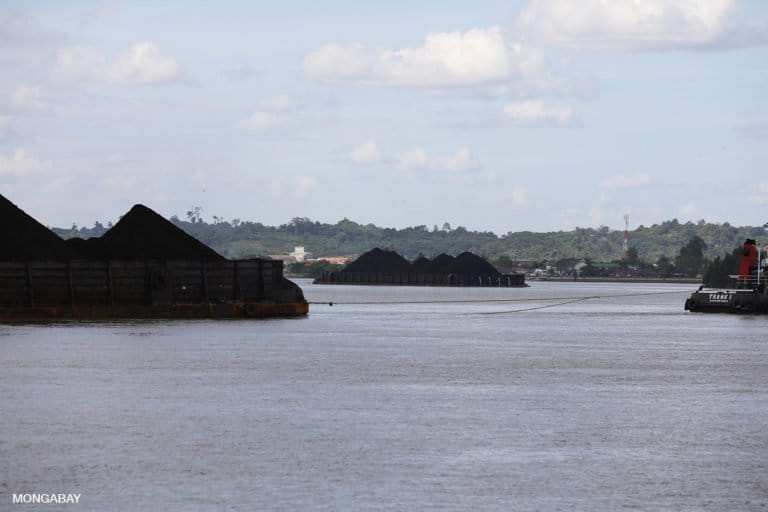- Indonesia is building several new coal-fired power plants for industrial users, despite its stated commitment to start phasing out coal and transition to clean energy, according to a new report.
- These so-called captive coal plants will have a combined capacity of 13 gigawatts, accounting for more than two-thirds of the 18.8 GW of new coal power in the pipeline.
- Most of the plants will feed the nickel, cobalt and aluminum smelters that the government is promoting in an effort to turn Indonesia into a manufacturing hub for electric vehicles (EVs) and batteries.
- Critics say the building spree goes against both these green technology aspirations and Indonesia’s own climate commitments, but regulatory and funding loopholes mean the government can freely build more new captive coal plants.
JAKARTA — Indonesia is on a spree of building coal-fired power plants for industry, which will keep the country addicted to the fossil fuel for the foreseeable future, regardless of its climate commitments, experts warn.
Coal currently accounts for around 43% of the country’s grid electricity, making Indonesia one of the world’s top fossil CO2 emitters. And it’s set to bring more coal power online, according to a recent report by the Global Energy Monitor (GEM), which uses publicly available data on company plans. The report shows Indonesia had 18.8 gigawatts of coal power considered under construction by the end of 2022.
This amount exceeds all other countries except China and India. It’s also nearly half of Indonesia’s current coal capacity, which stands at 40.6 GW.
Most of these new coal plants, 13 GW or 69%, will be “captive” plants, meaning they won’t feed into the grid, but will instead be dedicated to powering industrial or commercial consumers. These include the aluminum smelters and nickel and cobalt processing facilities that the government is promoting to turn Indonesia into a global hub for the electric vehicle (EV) and battery supply chains.
These new coal plants in the pipeline make it more difficult for Indonesia to transition away from its coal consumption, a key action for its climate change action plan, according to Rere Jambore Christanto, a mining and energy campaign manager at the Indonesian Forum for the Environment (Walhi).
“With an additional capacity of 13 GW in captive coal plants, it means that our consumption of coal will continue to grow,” he told Mongabay.

Canceling out emissions cuts
The new plants coming online will also negate — and then some — any effort by the government to cut the coal capacity in the grid as part of Indonesia’s wider emissions reduction plan, Rere said. In 2022, the government announced it would cancel more than 8 GW of new coal plants.
Shutting down Indonesia’s entire fleet of 118 coal plants by 2040 would require an estimated $37 billion. In November 2022, Indonesia struck a deal called the Just Energy Transition Partnership (JETP) with the G7 group of industrialized countries plus Denmark and Norway on $20 billion in funding to help speed up its energy transition.
The money will allow Indonesia to retire 5.2 GW of existing coal power in the initial phase of the project. Together with other funding commitments, Indonesia is estimated to be able to retire around 9 GW of coal power, Rere said.
That number, he pointed out, is less than half the additional 18.8 GW of captive and grid coal power that’s expected to come online in the future.
“So there’s more coal power, including captive, that will be built than the capacity that will be retired,” Rere said. “This will increase our emissions, even though we know that our emissions [from the energy sector] should peak in 2030.”

All that glitters is … nickel
Bhima Yudhistira Adhinegara, executive director of the Center of Economic and Law Studies (CELIOS), attributed the prevalence of captive coal plants to the Indonesian government’s efforts to process mineral resources in the country as a way of profiting from the added value.
“There’s a massive downstream processing effort for mineral resources [in Indonesia],” he said. “It is massive and out of control.”
One such mineral that the government is promoting heavily is nickel, of which Indonesia is the world’s top producer. The metal is a key element in the batteries that power EVs and energy storage systems, and the government is banking on its nickel reserves to become an EV powerhouse.
Indonesia is already ramping up its nickel production in response to global demand: In 2022, its nickel production increased by 60%, accounting for half of global production.
The production of battery-grade nickel requires intensive processing of the metal, which in turn has driven the construction of new smelters throughout Indonesia. As of the end of 2022, the country had 15 nickel smelters and plans to build at least six more.
These smelters demand a lot of energy to process low-grade nickel into battery-grade nickel, which is where the captive coal plants come in.
A recent report by CELIOS shows the coal plant-building spree is very much tied to EV battery production, with most of the plants serving the steel and nickel processing industries on the islands of Sulawesi and Maluku. These in turn are funded mostly by Chinese companies.
Three industrial estates dedicated to nickel are already in operation on Obi Island, Morowali and Weda Bay, and will be powered by a combined 14 captive coal plants churning out a total 12.6 GW — a fourth of Germany’s total coal capacity.
That figure is also more than double the 6.1 GW currently feeding the entire nickel industry in Indonesia, highlighting the scale of Indonesia’s nickel ambitions.
On the island of Bintan, less than an hour by boat from Singapore, there are plans to build 31 captive coal plants with total capacity of 3.2 GW, which is more than the entire coal capacity of France.
The nickel industry’s reliance on coal means that Indonesia’s climate road map is extremely flawed, Walhi’s Rere said. Detractors have long made the case that while EVs have virtually no emissions while in operation, their production is 30-40% more carbon intensive than that of an internal combustion engine vehicle — with much of that footprint coming from the production of the batteries.
Couple that with the coal that Indonesia plans to use to make those batteries, and “extracting minerals to meet our EV demand actually increases our emissions, instead of reducing them,” Rere said.

Regulatory loopholes
In 2021, the administration of President Joko Widodo announced an end to new coal-fired power plants after 2023.
But the slate of under-construction plants, including the captive ones, is still allowed because the president issued a regulation in 2022 that waters down the moratorium and the commitments to phase out coal.
The regulation stipulates that new coal plants can still be developed and operated until 2050 as long as they’re “integrated with industries that are built orientated to increase the added value of natural resources or are included in the national strategic projects that have a major contribution to job creation and/or national economic growth.”
The nickel and aluminum smelters fall under both categories — metal refining and nationally strategic — which means there’s no limit to the number of coal plants that can be built to serve them.
Another loophole in the regulation is that new coal plants can be built if the operator can commit to cutting their greenhouse gas emissions by 35% within 10 years of operation.
This loophole also exists in the JETP agreement, which calls for a moratorium on “new” on-grid coal power generation, but allows exemptions for captive coal plants in accordance with the 2022 regulation.
The JETP also allows exemptions for coal plants previously identified in the government’s most recent 10-year electricity procurement plan, also known as the RUPTL.
The JETP secretariat, formed by the Indonesian government to manage the energy transition program, said nothing had been set in stone regarding whether captive coal plants would still be allowed under the mechanism. This is because the JETP secretariat is still working on an investment and policy plan, which will specify how the JETP will achieve its target and outline the funding commitment, according to Adhityani Putri, a spokesperson for the secretariat.
The investment and policy plan is expected to be published Aug. 16.

Financial risks
Bhima of CELIOS said the development of new captive coal plants is clearly at odds with the basis of the JETP, whose ultimate goal is to help Indonesia transition away from coal.
Besides accelerating global warming, new coal plant developments also pose a tremendous financial risk, he added.
To limit global warming to the Paris Agreement threshold of 1.5° Celsius (2.7° Fahrenheit) above pre-industrial levels, an estimated 60% of oil and gas reserves and 90% of known coal reserves must remain unused. That would make new coal plants redundant, and therefore an instant money pit for investors and governments, Bhima said.
Even existing coal plants are a risk, as they have to be retired 10 to 30 years earlier than previously to meet international climate goals, leaving many short of generating a return on investment.
Fluctuating coal prices are another red flag for would-be investors, Bhima said.
“Coal is known as a commodity with fluctuating price, and for people who own coal power plants, this creates business uncertainty,” he said. “So for banks who already know that this is an unsustainable business, not only in terms of the environment, but also [financial] risks, this is a ridiculous business.”
He pointed to a plunge in coal prices from 2013-2015, which left many coal companies unable to pay back their bank loans.
“So coal is not good for the economy at all. If banks want to maintain the quality of their credit, don’t invest in coal,” he said.
Worldwide, a growing number of banks and investment funds have stopped funding coal mining and power plants, as part of their pledge to divest from carbon-intensive businesses. Many of these institutions are part of the U.N.’s Net-Zero Banking Alliance, accounting for about 41% of global banking assets. To date, 132 banks in 41 countries have joined the alliance.
Some banks have explicitly said they will divest their holdings in Indonesian coal companies. The U.K.’s Standard Chartered and Singapore’s DBS both announced they would stop funding Adaro Energy, Indonesia’s largest coal miner. This includes Adaro’s $2 billion project to build an aluminum smelter and captive coal plants on the island of Borneo.
But local banks are lagging behind lenders elsewhere when it comes to ending coal financing, with not a single bank from Indonesia joining the net-zero alliance. In fact, five Indonesian banks — Mandiri, BNI, BCA, BRI and Permata — have agreed to fund Adaro’s smelter project and the coal power plants.
Mandiri, BNI and BRI are state-owned banks and thus feel less risk in investing in coal, Bhima said. That’s left them without a sense of crisis regarding climate change, he added.
“But the problem is there’s a growing number of depositors who are concerned about climate change. Furthermore, state-owned banks also have syndicated loan projects with international banks that are committed to net zero,” Bhima said.
“So come on, [Indonesian] banks. It’s not like there’s no other business [to invest in] other than coal. Green energy needs a lot of investment, and the majority of them have profits that are quite lucrative.”
Citations:
Welsby, D., Price, J., Pye, S., & Ekins, P. (2021). Unextractable fossil fuels in a 1.5 °C world. Nature, 597(7875), 230-234. doi:10.1038/s41586-021-03821-8
Fofrich, R., Tong, D., Calvin, K., De Boer, H. S., Emmerling, J., Fricko, O., … Davis, S. J. (2020). Early retirement of power plants in climate mitigation scenarios. Environmental Research Letters, 15(9), 094064. doi:10.1088/1748-9326/ab96d3
Banner image: A coal-fired power plant. Image courtesy of Benita Welter from Pixabay.
FEEDBACK: Use this form to send a message to the author of this post. If you want to post a public comment, you can do that at the bottom of the page.



